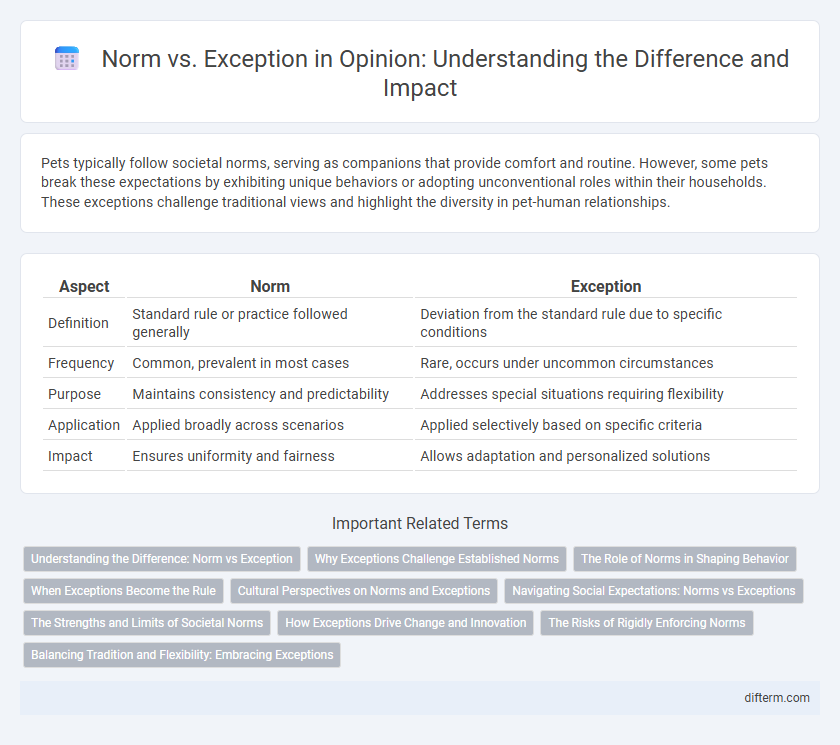Pets typically follow societal norms, serving as companions that provide comfort and routine. However, some pets break these expectations by exhibiting unique behaviors or adopting unconventional roles within their households. These exceptions challenge traditional views and highlight the diversity in pet-human relationships.
Table of Comparison
| Aspect | Norm | Exception |
|---|---|---|
| Definition | Standard rule or practice followed generally | Deviation from the standard rule due to specific conditions |
| Frequency | Common, prevalent in most cases | Rare, occurs under uncommon circumstances |
| Purpose | Maintains consistency and predictability | Addresses special situations requiring flexibility |
| Application | Applied broadly across scenarios | Applied selectively based on specific criteria |
| Impact | Ensures uniformity and fairness | Allows adaptation and personalized solutions |
Understanding the Difference: Norm vs Exception
Understanding the difference between norm and exception is crucial in recognizing patterns and deviations within any context. Norm represents the standard or typical occurrence, while an exception signifies a deviation from this standard, often highlighting unique or rare situations. Distinguishing these concepts improves decision-making and analytical clarity.
Why Exceptions Challenge Established Norms
Exceptions challenge established norms by exposing the limitations and rigidity of widely accepted rules, prompting critical evaluation and potential revision. They highlight unique circumstances or diverse contexts that norms may fail to address, revealing gaps in understanding and application. This disruption encourages adaptability and innovation within systems, fostering progress and more inclusive frameworks.
The Role of Norms in Shaping Behavior
Norms function as unwritten rules that guide individual behavior within a society, establishing predictable standards that facilitate social cohesion. They influence decision-making by creating expectations that reward conformity and discourage deviance, thereby reinforcing collective values. Exceptions challenge these norms but also highlight their importance in maintaining order and shaping communal identity.
When Exceptions Become the Rule
When exceptions increasingly appear in everyday practices, they gradually redefine the norm, shifting societal expectations and standards. This dynamic challenges traditional frameworks by embedding flexibility and adaptability into institutional policies and cultural behaviors. Recognizing when exceptions evolve into rules is essential for effective governance and social cohesion in rapidly changing environments.
Cultural Perspectives on Norms and Exceptions
Cultural perspectives shape the understanding of norms and exceptions by defining what behaviors are considered standard or deviant within a community, influencing social acceptance and enforcement. Norms vary widely across societies, reflecting collective values, traditions, and historical contexts, while exceptions challenge these norms and often drive social change or highlight cultural tensions. The dynamic interplay between established norms and recognized exceptions reveals the fluidity of cultural identity and the capacity for adaptation in diverse social environments.
Navigating Social Expectations: Norms vs Exceptions
Understanding social expectations requires differentiating between norms, which represent collective behaviors accepted by the majority, and exceptions, which challenge or deviate from these standards. Norms provide a framework for predictable interactions and social cohesion, while recognizing exceptions fosters inclusivity and innovation. Successfully navigating this balance enhances interpersonal relationships and cultural adaptability.
The Strengths and Limits of Societal Norms
Societal norms provide a framework that fosters social cohesion and predictability by establishing shared expectations and behaviors. Their strength lies in promoting order and stability across communities, yet rigid adherence can stifle individuality and hinder social progress. Exceptions to norms often catalyze innovation and cultural evolution, highlighting the balance between conformity and change essential for dynamic societies.
How Exceptions Drive Change and Innovation
Exceptions challenge established norms by introducing new perspectives that disrupt routine practices. These deviations foster creativity and experimentation, leading to breakthroughs in technology, culture, and business models. Embracing exceptions accelerates progress by encouraging adaptive thinking and continuous improvement.
The Risks of Rigidly Enforcing Norms
Rigidly enforcing norms can stifle creativity and suppress individuality, leading to a culture of conformity that discourages innovation. Exceptional cases often drive progress by challenging established patterns and encouraging new perspectives. Ignoring these exceptions risks missing opportunities for growth and adaptability in rapidly changing environments.
Balancing Tradition and Flexibility: Embracing Exceptions
Balancing tradition with flexibility involves recognizing the value of established norms while embracing exceptions that drive innovation and growth. This approach fosters a dynamic environment where rules provide stability, yet exceptions enable adaptation to unique circumstances. Embracing exceptions cultivates a culture that honors heritage without stifling progress or creativity.
norm vs exception Infographic

 difterm.com
difterm.com